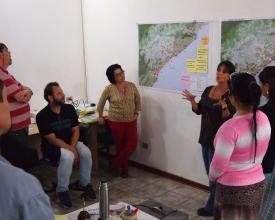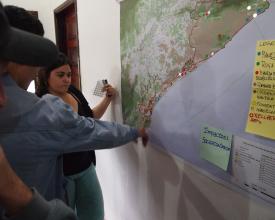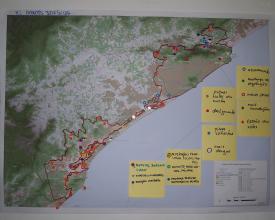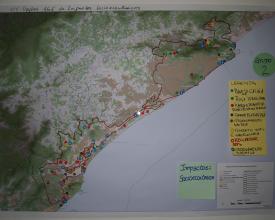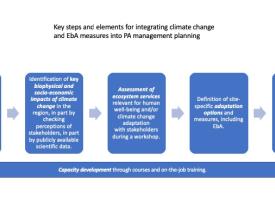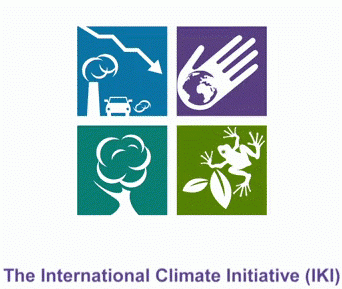
Intégration de l'adaptation fondée sur les écosystèmes dans la planification de la gestion des zones protégées
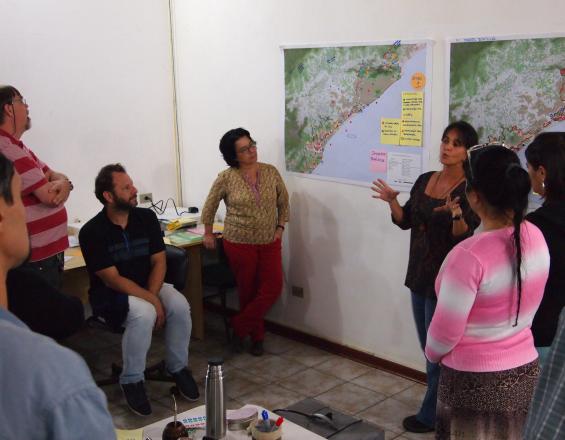
La solution décrit un processus pilote au Brésil visant à intégrer les risques et les opportunités liés au changement climatique ainsi que des mesures d'adaptation basées sur les écosystèmes dans le plan de gestion de la zone protégée "Cananéia-Iguape-Peruíbe". Cette zone fait partie du "Mosaico Lagamar", un réseau de sites de conservation dans la forêt tropicale atlantique. Cette solution donne un aperçu de l'approche et de ses aspects méthodologiques, ainsi que des indications concrètes pour la reproduction dans d'autres processus de planification de zones protégées.
Contexte
Défis à relever
La Mata Atlântica abrite plus de 120 millions de personnes et constitue le moteur de l'économie brésilienne, générant plus de 70 % de la production économique du pays. La région est un important point chaud de la biodiversité, bien qu'elle comprenne des mégapoles telles que São Paulo et Rio de Janeiro. Dans l'ensemble, environ 22 % de la végétation naturelle des forêts de la côte atlantique a été préservée et le taux de déforestation est stable et faible. Néanmoins, le degré élevé de fragmentation des zones forestières restantes continue de compromettre le maintien de la biodiversité et des services écosystémiques. Ces dernières années, des événements climatiques extrêmes tels que des inondations et de longues périodes de sécheresse ont eu des conséquences socio-économiques dévastatrices pour la population et l'économie. Le défi dans ce biome réside dans la conservation et la restauration des forêts naturelles afin de garantir les services écosystémiques qui sont importants pour la vie et les affaires, tels que l'approvisionnement en eau potable des grandes zones métropolitaines.
Emplacement
Traiter
Résumé du processus
Le Building block (BB) 1 : Approche méthodologique pour l'intégration du changement climatique et de l'EbA dans la planification de la gestion des zones protégées est la pièce maîtresse de la solution. Il fournit les lignes directrices du processus de mise en œuvre (BB 3 : conception et mise en œuvre du processus participatif), tandis que le BB 2 : ancrage institutionnel et mise à l'échelle est l'un des résultats escomptés de l'initiative. Le processus participatif et le développement continu des capacités ont ouvert la voie au développement et à la mise en œuvre de l'approche méthodologique, tandis que son transfert à d'autres zones protégées est essentiel pour l'ancrer davantage dans la planification des zones protégées au Brésil.
Blocs de construction
Approche méthodologique pour l'intégration du changement climatique et des mesures d'EbA dans la planification de la gestion des zones protégées
L'approche méthodologique comprend les étapes suivantes (voir aussi le graphique dans la galerie) :
- Collecte des perceptions des professionnels concernés et d'autres parties prenantes concernant les principaux risques climatiques et cartographie spatiale de ces risques.
- Identification des principaux impacts biophysiques et socio-économiques du changement climatique dans la région, en partie en vérifiant les perceptions des parties prenantes, en partie en s'appuyant sur des données scientifiques accessibles au public.
- Évaluation des services écosystémiques pertinents pour le bien-être humain et/ou l'adaptation au changement climatique avec les parties prenantes au cours d'un atelier.
- Définition d'options et de mesures d'adaptation spécifiques au site, y compris l'EbA.
- Intégration des résultats dans le plan de gestion.
- Le développement des capacités par le biais de cours et de formations en cours d'emploi est une mesure d'accompagnement essentielle.
Facteurs favorables
- la disponibilité de connaissances et d'informations scientifiques et d'autres types et sources de connaissances et d'informations
- Participation et contribution du personnel technique et des citoyens.
Leçon apprise
- La première étape consistait à améliorer les connaissances des participants sur les concepts et les questions liés au changement climatique. À cet égard, le format dynamique et participatif des réunions et des ateliers a été crucial pour renforcer la compréhension des principaux concepts et l'appréciation et l'intégration des perspectives et des connaissances des parties prenantes dans le plan de gestion.
- L'évaluation des risques doit aller au-delà du site de conservation et porter sur l'ensemble de sa zone d'influence (par exemple, les bassins hydrographiques comme orientation pour le champ d'application).
- Les approches participatives et l'intégration des perceptions des impacts du changement climatique peuvent donner lieu à des points de vue divergents. L'équipe responsable doit être préparée à y faire face.
- De même, la collecte des connaissances et des perceptions locales peut nécessiter des ressources importantes et doit être bien préparée.
- L'intégration des risques liés au changement climatique et la mise en œuvre de mesures d'adaptation dans la gestion de la conservation est une tâche relativement nouvelle et complexe qui est influencée par des facteurs variant d'un site à l'autre. C'est pourquoi le processus d'adaptation doit être spécifique à chaque zone.
Ancrage institutionnel et généralisation
Grâce à l'élaboration d'un programme d'action EbA, l'approche EbA a été institutionnellement ancrée dans la zone protégée "Cananéia-Iguape-Peruíbe". En outre, l'approche méthodologique sera appliquée dans onze autres zones protégées dans quatre États fédéraux du pays grâce à des partenariats stratégiques avec le ministère brésilien de l'environnement (MMA), l'agence brésilienne de l'environnement (ICMBio) et d'autres organismes. L'objectif est qu'à l'avenir, tous les plans de gestion des zones protégées considèrent l'EbA comme une réponse stratégique au changement climatique.
Facteurs favorables
- Des accords avec le personnel responsable de l'élaboration et de l'approbation des plans de gestion au niveau central de l'autorité responsable de la zone protégée et le soutien de ce personnel.
- Les partenariats avec d'autres projets et financiers sont un catalyseur important et un point de déclenchement pour la reproduction, l'extension et l'élargissement.
Leçon apprise
- L'élaboration d'approches méthodologiques prêtes à l'emploi et la promotion de leur diffusion et de leur intégration nécessitent du temps ainsi que des ressources financières et personnelles.
- Il est nécessaire de trouver un équilibre entre les questions généralisables et les questions spécifiques au contexte.
Conception et mise en œuvre d'un processus participatif
Le point de départ a été l'accord sur les étapes méthodologiques (voir BB 1) du projet pilote, y compris l'implication des principales parties prenantes et les besoins et mesures de développement des capacités. La révision prochaine du plan de gestion a constitué un point de départ idéal pour l'intégration de l'EbA et le plan de travail en a été l'instrument clé. Il définit que l'EbA doit être traité lors de réunions thématiques avec différents groupes de parties prenantes et d'un atelier, dans un chapitre spécifique du plan de gestion et dans le cadre d'un programme d'action EbA. La formation de l'équipe centrale a été suivie par la collecte de données et d'informations relatives au climat, qui ont été utilisées lors des sessions avec les communautés et d'un atelier.
Facteurs favorables
- Accord et soutien du personnel responsable de l'approbation des plans de gestion.
- Plan de travail clairement défini et largement accepté.
Leçon apprise
-
Le processus d'adaptation doit prendre en compte les caractéristiques de l'écosystème et les conditions sociales et économiques à l'intérieur et au-delà des limites des zones protégées. Par conséquent, un processus continu et participatif est nécessaire, abordant les priorités de conservation, les risques climatiques et autres, ainsi que les besoins et les intérêts des parties prenantes.
- Plus le processus est participatif, plus l'approche EbA a de chances d'être intégrée dans le plan de gestion de la zone protégée.
- Il est nécessaire d'identifier et d'impliquer tous les départements et niveaux hiérarchiques des organisations responsables de la zone protégée afin d'assurer l'intégration de l'EbA. Dans notre cas, la révision finale par les supérieurs a entraîné des retards et des observations, car certains d'entre eux n'avaient pas été impliqués auparavant.
- Il est important d'impliquer des professionnels ayant une expérience de l'EbA et de la planification de la gestion des zones protégées. Tout d'abord, le projet devait qualifier les professionnels et les autres parties prenantes impliquées dans le processus afin de réussir l'intégration de l'approche EbA dans le plan de gestion.
Impacts
- Le personnel technique et les habitants sont conscients des risques liés au changement climatique et du potentiel des mesures EbA dans la zone protégée.
- Les capacités d'identification et de mise en œuvre des mesures d'EbA ont été renforcées.
- L'équipe d'administration de la zone protégée dispose désormais d'un plan de gestion moderne qui met l'accent sur le maintien des services écosystémiques, notamment par le biais de mesures d'AEB. Sa mise en œuvre contribuera à la réduction des risques liés au changement climatique et renforcera les synergies entre les mesures d'adaptation au changement climatique et de conservation de la biodiversité.
- Une orientation méthodologique susceptible d'être reproduite dans d'autres domaines est disponible.
- Les expériences et les enseignements tirés ainsi que les aspects conceptuels et méthodologiques de cette expérience pilote seront pris en compte lors de l'élaboration/la mise à jour de 11 plans de gestion supplémentaires au cours des deux prochaines années.
Bénéficiaires
Direct : Personnel des zones protégées, autorités régionales et locales
Indirectes : Population (par le biais des services écosystémiques)
Objectifs de développement durable
Histoire
Le projet Mata Atlântica a commencé ses activités dans la région de Lagamar (côte sud de São Paulo et côte du Paraná) en 2014 avec un programme de développement des capacités sur l'EbA : les membres du personnel de l'aire protégée " Cananéia-Iguape-Peruíbe " (APACIP) et d'autres institutions partenaires ont été formés sur les bases de l'EbA. La formation a commencé par une discussion sur le potentiel de l'EbA dans la région et sur les moyens de la mettre en œuvre. En conséquence, le plan de gestion de l'APACIP a été le premier à intégrer des mesures d'EbA et la méthodologie de travail facile à utiliser servira, nous l'espérons, de référence théorique/pratique à d'autres.
"Mon implication dans le thème de l'adaptation basée sur les écosystèmes [en espagnol : AbE] a commencé lors du cours AbE, qui s'est tenu en juillet 2014 à Cananéia, São Paulo. Plus tard, j'ai participé au cours de formation des formateurs en AbE qui s'est tenu en septembre 2014 à Brasília DF (District fédéral). Après avoir participé au cours, et en raison de la proximité, j'ai proposé l'insertion de l'approche AbE dans le processus d'élaboration du plan de gestion de l'APACIP. L'approche a apporté une contribution importante à la perception qu'ont les gens du changement climatique et de ses effets sur leurs activités quotidiennes, ainsi qu'aux processus d'identification des impacts environnementaux potentiels et à la proposition de solutions alternatives aux impacts les plus probables. En collaboration avec les chefs des communautés locales, les adaptations possibles basées sur les écosystèmes ont été diagnostiquées en fonction de leurs perceptions du changement climatique et ont été intégrées dans le contenu du plan de gestion. En particulier, je pense que l'élaboration et la publication du plan de gestion de l'APACIP incluant l'EbA a été un effort heureux de la part de professionnels et de personnes intéressées par la gestion des ressources naturelles de l'APACIP, dans une fenêtre d'opportunité rare dans l'administration publique, aboutissant à un document de planification de base, avec le potentiel de stimuler les progrès dans la gestion territoriale de la mosaïque estuarienne de Cananéia, Iguape, Ilha Comprida et Peruíbe".
Miguel Fluminhan Filho, analyste environnemental, APA Cananéia Iguape Peruíbe

